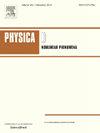Unveiling connections: Mobility and dengue case networks on an intraurban scale
IF 2.7
3区 数学
Q1 MATHEMATICS, APPLIED
引用次数: 0
Abstract
This study examines the intraurban connections between mobility and dengue case networks in São José dos Campos, São Paulo, Brazil. Our research aims to elucidate the correlation between human mobility patterns and the spread of dengue, a significant public health issue exacerbated by urban infrastructure deficits. We used daily dengue case data from 2014 to 2024 and mobility data derived from a 2011 urban mobility survey to build a complex network. Using mutual information, Spearman rank correlation, and linear regression, we quantified that regions that are geographically closer or have a greater flow of people between them have remarkable similarities between their time series of dengue cases. Our findings indicate that mobility significantly influences dengue spread, with higher mutual information values during periods of high dengue incidence, such as in 2015. As mobility increases, so does the correlation between dengue cases, underscoring the importance of considering intraurban mobility in public health strategies. In particular, our results demonstrate that mobility has a more significant influence than distance on the spread of cases. These insights could inform more effective epidemic control measures and urban planning policies to mitigate the impact of arboviruses in densely populated areas.

揭示联系:城市内规模的流动性和登革热病例网络
本研究调查了巴西圣保罗 o jossore dos Campos地区交通与登革热病例网络之间的城市内联系。我们的研究旨在阐明人类流动模式与登革热传播之间的相关性,登革热是一个因城市基础设施不足而加剧的重大公共卫生问题。我们使用2014年至2024年的登革热病例数据和2011年城市交通调查得出的交通数据来构建一个复杂的网络。利用互信息、Spearman秩相关和线性回归,我们量化了地理上距离较近或人员流动较大的地区在登革热病例时间序列之间具有显著的相似性。我们的研究结果表明,流动性显著影响登革热的传播,在登革热高发时期,如2015年,相互信息值更高。随着流动性的增加,登革热病例之间的相关性也在增加,这强调了在公共卫生战略中考虑城市内流动性的重要性。特别是,我们的研究结果表明,流动性比距离对病例传播的影响更显著。这些见解可以为更有效的流行病控制措施和城市规划政策提供信息,以减轻虫媒病毒在人口稠密地区的影响。
本文章由计算机程序翻译,如有差异,请以英文原文为准。
求助全文
约1分钟内获得全文
求助全文
来源期刊

Physica D: Nonlinear Phenomena
物理-物理:数学物理
CiteScore
7.30
自引率
7.50%
发文量
213
审稿时长
65 days
期刊介绍:
Physica D (Nonlinear Phenomena) publishes research and review articles reporting on experimental and theoretical works, techniques and ideas that advance the understanding of nonlinear phenomena. Topics encompass wave motion in physical, chemical and biological systems; physical or biological phenomena governed by nonlinear field equations, including hydrodynamics and turbulence; pattern formation and cooperative phenomena; instability, bifurcations, chaos, and space-time disorder; integrable/Hamiltonian systems; asymptotic analysis and, more generally, mathematical methods for nonlinear systems.
 求助内容:
求助内容: 应助结果提醒方式:
应助结果提醒方式:


